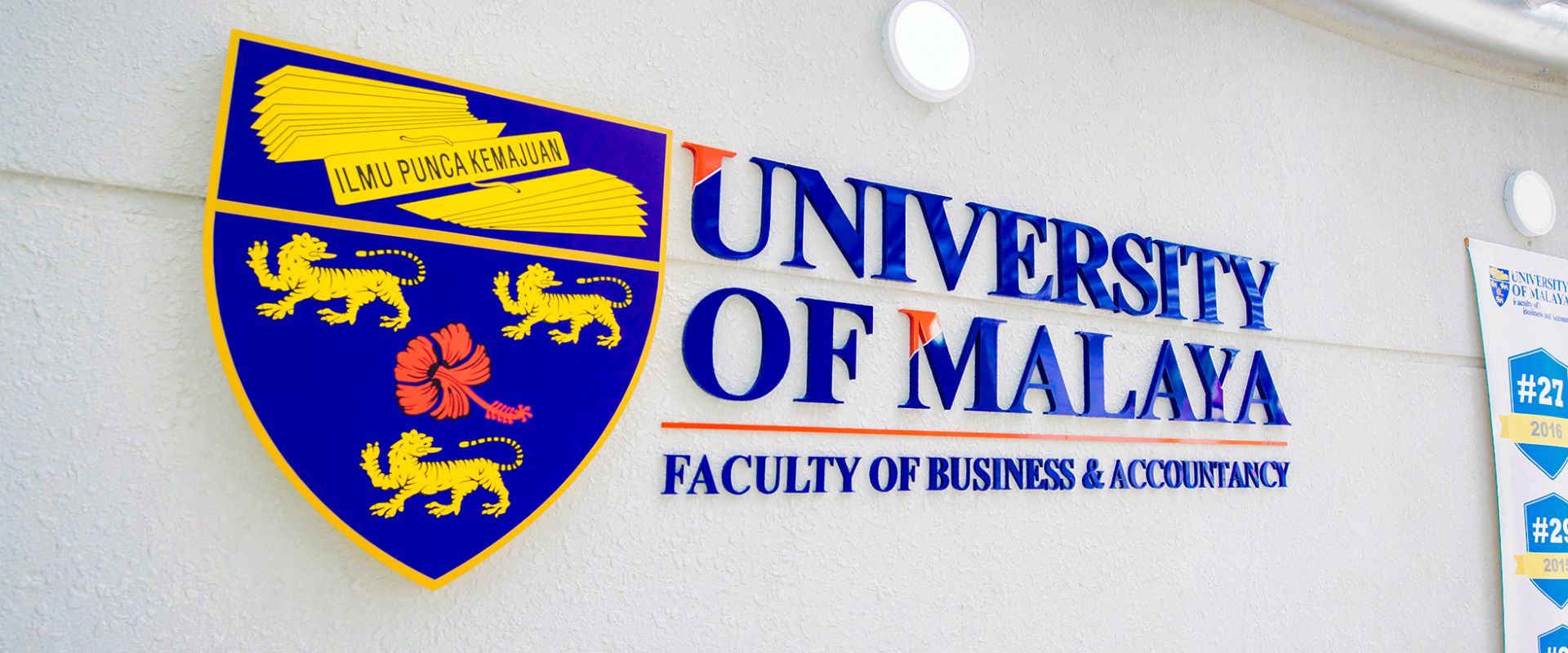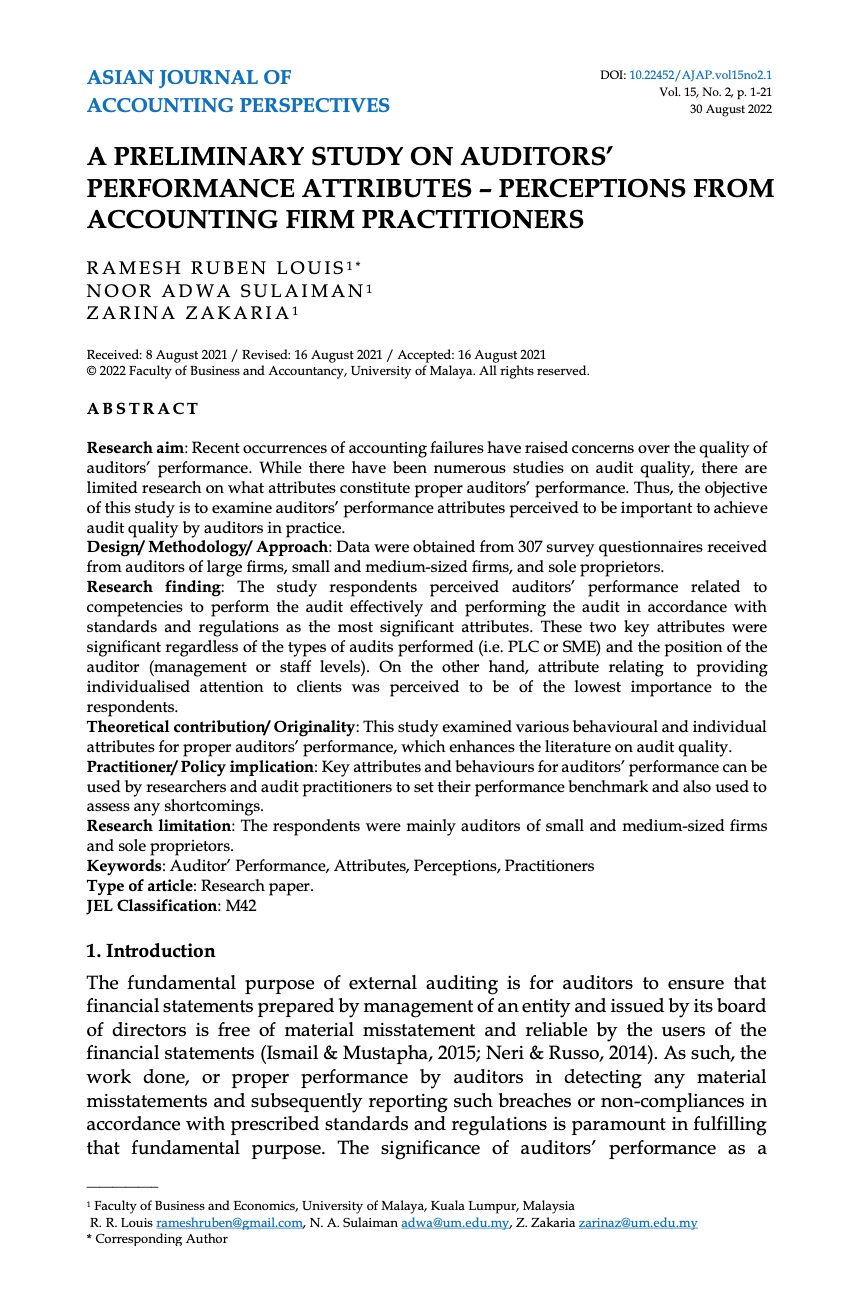A Preliminary Study on Auditors’ Performance Attributes – Perceptions from Accounting Firm Practitioners
Main Article Content
Abstract
Research aim: Recent occurrences of accounting failures have raised concerns over the quality of auditors’ performance. While there have been numerous studies on audit quality, there are limited research on what attributes constitute proper auditors’ performance. Thus, the objective of this study is to examine auditors’ performance attributes perceived to be important to achieve audit quality by auditors in practice.
Design/ Methodology/ Approach: Data were obtained from 307 survey questionnaires received from auditors of large firms, small and medium-sized firms, and sole proprietors.
Research finding: The study respondents perceived auditors’ performance related to competencies to perform the audit effectively and performing the audit in accordance with standards and regulations as the most significant attributes. These two key attributes were significant regardless of the types of audits performed (i.e. PLC or SME) and the position of the auditor (management or staff levels). On the other hand, attribute relating to providing individualised attention to clients was perceived to be of the lowest importance to the respondents.
Theoretical contribution/ Originality: This study examined various behavioural and individual attributes for proper auditors’ performance, which enhances the literature on audit quality.
Practitioner/ Policy implication: Key attributes and behaviours for auditors’ performance can be used by researchers and audit practitioners to set their performance benchmark and also used to assess any shortcomings.
Research limitation: The respondents were mainly auditors of small and medium-sized firms and sole proprietors.
Keywords: Auditor’ Performance, Attributes, Perceptions, Practitioners
Type of article: Research paper.
JEL Classification: M42
Downloads
Article Details
License
The Asian Journal of Accounting Perspectives (AJAP) articles are published under a licence equivalent to the Creative Commons Attribution-NonCommercial-NoDerivs License (CC BY-NC-ND). The licence allows users to copy, distribute, and transmit an article as long as the author is attributed. The article is not used for commercial purposes. The work is not modified or adapted in any way.
Copyright
Authors are required to sign the Exclusive License to Publish agreement upon publication in the AJAP. The agreement grants the Publisher (Faculty of Business and Accountancy, Universiti Malaya) to publish and disseminate the articles.
Open Access
Articles published in the AJAP are digital, online, free of charge, and free of most copyright and licensing restrictions.
Article Processing Charge
Articles publish in AJAP is free submission, production and publication charges. However, all accepted articles are required for language editing. The AJAP officially appointed and outsourced proofreader will conduct this process, and the authors will cover the cost. AJAP does not profit from this process and transaction.
References
Alderman, C. W., & Deitrick, J. W. (1982). Auditors' perceptions of time budget pressures and premature sign-offs: A replication and extension. Auditing: A Journal of Practice & Theory, 1(2), 54-68.
Audit Oversight Board, Securities Commission Malaysia (AOB). (2021). Annual Inspection Report 2020. https://www.sc.com.my/api/documentms/download.ashx?id=5a9f2acb-a4f9-4f12-bc71-03e519fb3807
Beck, P. J., & Wu, M. G. H. (2006). Learning by Doing and Audit Quality. Contemporary Accounting Research, 23(1), 1-30. https://doi.org/10.1506/AXU4-Q7Q9-3YAB-4QE0
Behn B. K., Carcello J. V., Hermanson D. R., & Hermanson R. H. (1997). The determinants of audit client satisfaction among clients of Big 6 firms. Accounting Horizons, 11(1), 7-24.
Bills, K.L., Swanquist, Q.T. & Whited, R.L. (2016). Growing Pains: Audit Quality and Office Growth. Contemporary Accounting Research, 33(1), 288-313. https://doi.org/10.1111/1911-3846.12122
Brannen, J. (2017). Combining qualitative and quantitative approaches: an overview. In Mixing methods: Qualitative and Quantitative Research (pp. 3-37). Routledge.
Broberg, P., Tagesson, T., Argento, D., Gyllengahm, N., & Martensson, O. (2017). Explaining the influence of time budget pressure on audit quality in Sweden. Journal of Management & Governance, 21(2), 331-350. https://doi.org/10.1007/s10997-016-9346-4
Cameran, M., Ditillo A., & Pettinicchio, A. (2018). Audit Team Attributes Matter: How Diversity Affects Audit Quality. European Accounting Review, 27(4), 595-621. https://doi.org/10.1080/09638180.2017.1307131
Carcello, J.V., Hermanson, R.H., & McGrath, N.T. (1992). Audit Quality Attributes: The Perceptions of Audit Partners, Preparers and Financial Statement Users. Auditing: A Journal of Practice and Theory, 11(1), 1-15.
Carcello, J.V., Hollingsworth, C., & Mastrolia, S.A. (2011). The effect of PCAOB inspections on Big 4 audit quality. Research in Accounting Regulation, 23(2), 85-96. https://doi.org/10.1016/j.racreg.2011.10.001
Center for Audit Quality (CAQ). (2014). CAQ Approach to Audit Quality Indicators. https://www.thecaq.org/wp-content/uploads/2019/03/caq-approach-to-audit-quality-indicators-april-2014.pdf
Chadegani, A.A. (2011). Review of studies on audit quality. Available at SSRN: https://ssrn.com/abstract=2227359 or https://dx.doi.org/10.2139/ssrn.2227359
DeAngelo, L. E. (1981). Auditor size and audit quality. Journal of Accounting and Economics, 3(3), 183-199. https://doi.org/10.1016/0165-4101(81)90002-1
Duff, A. (2004). AUDITQUAL: Dimensions of Audit Quality. Institute of Chartered Accountants of Scotland, Edinburgh.
Fouda, S. (2008). The role of accounting disclosure about intellectual capital’ information in the rationalization of credit and investment decision in the stock market: A theoretical and exploratory study. The Scientific Journal for Trade and Finance, 28(1), 147-205.
Fen, Y. S., & Sabaruddin, N. A. (2008). An extended model of theory of planned behaviour in predicting exercise intention. International Business Research, 1(4), 108-122. https://doi.org/10.5539/ibr.v1n4p108
Gaynor, L.M., Kelton, A.S., Mercer, M., & Yohn T.L. (2016). Understanding the Relation between Financial Reporting Quality and Audit Quality. Auditing: A Journal of Practice & Theory: 35(4), 1-22. https://doi.org/10.2308/ajpt-51453
Gul, F.A., Wu, D., & Yang, Z. (2013). Do Individual Auditors Affect Audit Quality? Evidence from Archival Data. The Accounting Review, 88(6), 1993–2023. https://doi.org/10.2308/accr-50536
Gunny, K.A., & Zhang, T.C. (2013). PCAOB inspection reports and audit quality, Journal of Accounting and Public Policy, 32(2), 36-160. https://doi.org/10.1016/j.jaccpubpol.2012.11.002
Hair, J. F., Black, W. C., Babin, B. J., Anderson, R. E., & Tatham, R. (2006). Multivariate Data Analysis (6th edition). Pearson-Prentice Hall.
Haron, H., Ibrahim, D., & Ismail, I. (2014). Factors Influencing Ethical Judgement of Auditors in Malaysia. Management & Accounting Review (MAR), 13(2), 47-86.
Hegazy, M., Raslan, I., & Eldawla, N. K. (2016). Quality control elements and auditor fraud risk assessment: An experimental study. Journal of Accounting and Finance, 16(2). https://www.articlegateway.com/index.php/JAF/article/view/1014
Herda, D.N., Cannon, N.H., & Young, R.F. (2019). The Effects of Supervisor Coaching and Workplace Mindfulness on Audit Quality-Threatening Behavior among Staff Auditors. Current Issues in Auditing, 13(1), 1-6. https://doi.org/10.2308/ciia-52324
Hoa, P., Pesi, A., Thanh, B., & Sang, T. (2014). A Study of Audit Quality in Vietnam. International Journal of Business, Accounting, & Finance, 8(2), 73-110.
Husnin, A. I., Nawawi, A., & Salin, A. S. A. P. (2016). Corporate governance and auditor quality–Malaysian evidence. Asian Review of Accounting, 24(2), 202-230. http://dx.doi.org/10.1108/ARA-11-2013-0072
Hussein, F., & Hanefah, M. (2013). Overview of Surrogates to Measure Audit Quality. International Journal of Business and Management, 8(17), 84-91. https://doi.org/10.5539/ijbm.v8n17p84
International Auditing and Assurance Standards Board (IAASB). (2014). A Framework for Audit Quality: Key Elements that Create an Environment for Audit Quality. https://www.ifac.org/system/files/publications/files/A-Framework-for-Audit-Quality-Key-Elements-that-Create-an-Environment-for-Audit-Quality-2.pdf
International Auditing and Assurance Standards Board (IAASB). (2009). International Standard on Quality Control (ISQC) 1, “Quality Control for Firms that Perform Audits and Reviews of Financial Statements, and Other Assurance and Related Services Engagements”. https://www.ifac.org/system/files/downloads/a007-2010-iaasb-handbook-isqc-1.pdf
Ismail, H., & Mustapha, M. (2015). Auditing the Auditors: The Audit Oversight Board and Regulating Audit Quality in Malaysia. Journal of Modern Accounting and Auditing, 11(3), 138-142. https://doi.org/10.17265/1548-6583/2015.03.002
Iskandar T., Sari R.N., Mohd-Sanusi Z, & Anugerah, R. (2012). Enhancing auditors’ performance. The importance of motivational factors and the mediation effect of effort. Managerial Auditing Journal, 27(5), 462-476. https://doi.org/10.1108/02686901211227959
Jolly, J. (2019). ‘Decline in quality': auditors face scrutiny over string of scandals’. The Guardian, International Edition. https://www.theguardian.com/business/2019/feb/01/decline-in-quality-auditors-face-scrutiny-over-string-of-scandals
Khadr, S. (2004). A field study on the relationship between experience and initial assessment of the risk of internal control under the electronic data. Journal of Economy and Trade, 23(1), 1-27.
Knechel, W.R., Krishnan, G.V., Pevzner, M., Shefchik, L.B., & Velury U.K. (2013). Audit Quality: Insights from the Academic Literature. Auditing: A Journal of Practice, 32 (Supplement 1), 385–421. https://doi.org/10.2308/ajpt-50350
Knechel, W. R., Thomas, E., & Driskill, M. (2020). Understanding financial auditing from a service perspective. Accounting, Organizations and Society, 81, 1-23. https://doi.org/10.1016/j.aos.2019.101080
Lightbody, M., & Single, L. (2011). Executive Positions in CPA Firms. Are director positions a new glass ceiling?. AICPA. https://www.aicpastore.com/Content/media/PRODUCER_CONTENT/Newsletters/Articles_2011/Career/ExecPositions.jsp
Louis, R.R., Sulaiman, N.A., & Zakaria, Z. (2020). Understanding Audit Quality and Talent Management of Auditors in Practice through Content Analysis and Interviews. Humanities and Social Sciences Letters, 8(1), 78-90. https://doi.org/10.18488/journal.73.2020.81.78.90
Malaysian Institute of Accountants (MIA). (2020). Trust and Sustainability in the Audit Profession. Practice Review Annual Report 2019/2020. https://www.mia.org.my/v2/downloads/resources/publications/surveillance/practice/2020/10/30/MIAPRAR2020.pdf
Malaysian Institute of Accountants (MIA). (2018). The Audit Profession in Malaysia. https://www.mia.org.my/v2/downloads/resources/publications/surveillance/practice/2018/MIA_The_Audit_Profession_2018.pdf
Malaysian Institute of Accountants (MIA). (2016). Why Audit Matters to SMEs. https://www.mia.org.my/v2/downloads/resources/publications/smp/2016/12/14/MIA_Why_Audit_Matters_to_SMEs.pdf
Mardijuwono, A. W., & Subianto, C. (2018). Independence, professionalism, professional skepticism. Asian Journal of Accounting Research, 3(1), 61-71. https://doi.org/10.1108/AJAR-06-2018-0009
Nagy, A.L. (2014). PCAOB Quality Control Inspection Reports and Auditor Reputation. AUDITING: A Journal of Practice & Theory, 33(3): 87–104. https://doi.org/10.2308/ajpt-50752
Nasution, D., & Östermark, R. (2020). The impact of auditors’ awareness of the profession’s reputation for independence on auditors’ ethical judgement. Social Responsibility Journal, 16(8), 1087-1105. https://doi.org/10.1108/SRJ-05-2018-0117
Neri, L., & Russo, A. (2014). A framework for audit quality: Critical analysis. Business and Management Review, 3(9), 25-30.
Owhoso, V. E., Messier, J. W. F., & Lynch, J. J. G. (2002). Error Detection by Industry-Specialized Teams during Sequential Audit Review. Journal of Accounting Research, 40(3), 883-900. https://doi.org/10.1111/1475-679X.00075
Peytcheva M., & Gillett P. R. (2012). Auditor perceptions of prior involvement and reputation threats as antecedents of quality threatening audit behavior. Managerial Auditing Journal, 27(9), 796-820. https://doi.org/10.1108/02686901211263058
Quick, R., & Rasmussen, B.W. (2005). The impact of MAS on perceived auditor independence-some evidence from Denmark. Accounting Forum, 29(2), 137-168. https://doi.org/10.1016/j.accfor.2004.09.001
Redmayne, N. B. (2013). Audit Quality - An Academic’s Perspective. Chartered Accountants Journal, 92(7), 26-27.
Smith, J. F., & Kilda, T. (1991). Heuristics and biases: Expertise and task realism in auditing. Psychological Bulletin, 109, 472-485. https://psycnet.apa.org/doi/10.1037/0033-2909.109.3.472
Sulaiman, N.A., Shahimi, S., & Singh, R.K.N. (2019). People and audit process attributes of audit quality: Evidence from Malaysia. Management & Accounting Review, 18(2), 47-80. http://dx.doi.org/10.24191/mar.v18i2.715
Suruhanjaya Syarikat Malaysia (SSM). (2016). Companies Act 2016. https://www.ssm.com.my/Pages/Legal_Framework/Companies%20-Act%20-1965-(Repealed)/aktabi_20160915_companiesact2016act777_0.pdf
Tsang, S., Royse, C. F., & Terkawi, A. S. (2017). Guidelines for developing, translating, and validating a questionnaire in perioperative and pain medicine. Saudi journal of anaesthesia, 11(Supplement 1), S80-S89. https://dx.doi.org/10.4103%2Fsja.SJA_203_17
Tysiac, K. (2016). Nurturing the human element. Journal of Accountancy; 222(1), 28-30, 32-33.
Watkins, A.L., Hillison, W., Morecroft, S.E. (2004). Audit Quality: A Synthesis of Theory and Empirical Evidence. Journal of Accounting Literature, 23(1), 153-193.
Zakaria, N. B., Yahya, N., & Salleh, K. (2013). Dysfunctional Behavior among Auditors: The Application of Occupational Theory. Journal of Basic and Applied Scientific Research, 3(9), 495-503.
Zandi, G., Sadiq, M., & Mohamad, S. (2019). Big-Four Auditors and Financial Reporting Quality: Evidence from Pakistan. Humanities & Social Sciences Reviews, 7(2), 369-375. https://doi.org/10.18510/hssr.2019.7243

